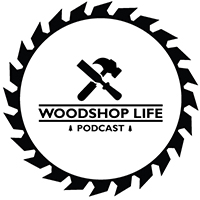This Episodes Questions:
Brian’s Questions:
I know planing before face jointing is sacraledge but I was recently visiting with an older experienced wood worker who noted he never face joints. Planes both sides then edge joints and it’s fine.
Thoughts? Thinking if you want it dead flat perfect or board is not great to start with jointing certainly makes sense. But anybody just plane it? Perhaps starting with a decent board it would work for most applications?
My 20” planer is a breeze to put wood through, the jointer is great but takes more effort/time if it’s not needed would be a nice step to drop.
Curious on your thoughts, Matt Wendig
I’m preparing to build a set of kitchen cupboards from white oak. The style will be Mission, with some Frank Lloyd Wright Prairies Style touches. I have several questions.
I need to cut up a lot of 3/4″ plywood. I have a good track saw and a cabinet tablesaw with side and outfeed tables. When watching videos of some people constructing kitchen cabinets, I’m surprised that they cut the sheet goods with the track saw but then cut them again, to final size, on the table saw. I imagined myself using the track saw only—to do very precise cuts to final size and not cutting the panels twice. What is your process? Any advice on maximizing my chances of getting near-perfect panels with the track saw only and avoiding the two-cuts process? Darrin
Guy’s Questions:
Hey guys, love the podcast. I’m making a screen door for the porch out of cedar that is 1.5” thick, 36” x 84” with 5.5” wide stiles and rails (top, middle and bottom). I have a festool DF500, if I used 10 x 50 dominoes for the joinery would that be strong enough or should I use traditional mortise and tenons?
I’ve read that cedar is pretty dimensionally stable. I was thinking about just staining or oiling the door (I don’t want it to turn gray) but does it need an actual topcoat to help keep it from warping? Just don’t want to use a finish that is going to flake off and I will have to sand and refinish every year or so. If it needs a topcoat could you recommend a finish?
Thanks,
Scott in Birmingham.
Throughly enjoy the pod cast. I am almost up to date on all past episodes and they hve been quite informative. Little back story on my question. Had a client contact me about repairing a dinning table they had built for their home. For clarity I didn’t build the table. The top is a solid wood glue up with breadboards on the ends. On one end of the top the breadboard sticks out about 1/16” past the rest of the top. On the other end 2 boards have a split between the glue line that stretches roughly 2 feet along their length. I’m sure it is from the wood contracting. Any pointers on how to repair the issue? I’m 99.9% sure the table top is made from southern yellow pine. It is stained with a top coat of poly acrylic. Robert
Huy’s Questions:
Hello guys,
I love the podcast and have learned a ton from you. Keep up the great work and thank you for your time.
I have a question on how you store your tools that require precision/calibration. Specifically, I have an Incra 5000 cross cut sled. When not in use, I store it standing on its side on the shop floor. Is there a better / more correct way? Similar question goes for any other shop made sled / jig that you expect to use over and over again. How do you store it?
Max
Greddie Woodworks
It was mentioned that one of you repalced the wheels on his band saw, do to it wearing out and it was a pain. I have bought a used 14 inch delta bandsaw, and I have no idea how to know if parts are worn out beside the obvious part being the blade. So how can I figure out parts are worn out, sources to shop for replacements ( no home depo in Okinawa) tips and or youtube videos on how to do these maintainance tasks? Oh and what you do to increase the function of a band saw, like would you buy a bow system fence for it?
Many thanks,
Paul Mitchell
Oki Mitch Crafts
